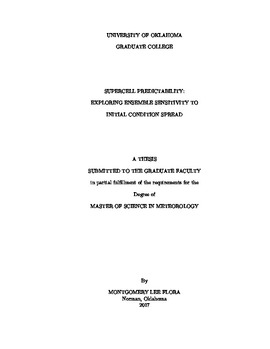| dc.contributor.advisor | Potvin, Corey | |
| dc.contributor.author | Flora, Montgomery | |
| dc.date.accessioned | 2017-05-11T13:38:35Z | |
| dc.date.available | 2017-05-11T13:38:35Z | |
| dc.date.issued | 2017-05-12 | |
| dc.identifier.uri | https://hdl.handle.net/11244/50766 | |
| dc.description.abstract | The sensitivity of full-physics ensemble forecasts of supercells to initial condition (IC) uncertainty is investigated. The motivation for the study largely stems from the NOAA Warn-on-Forecast (WoF) program, where the primary objective is to develop a storm-scale ensemble prediction system that will generate probabilistic guidance for severe weather forecasts and warnings. Motivation also stems from the need to develop a suitable full-physics/real data numerical weather prediction
(NWP) framework for studying storm-scale predictability.
Three sets of initial/boundary conditions for our simulations were generated from the real-time NSSL Experimental WoF System for Ensembles (NEWS-e) during the 2016 NOAA Hazardous Weather Testbed Spring Forecasting Experiment. The 3-km NEWS-e analyses were interpolated to a 1-km grid, then integrated for 3 hours. Our primary goal was not to replicate observed supercell evolution, but rather to isolate the e ffect of IC uncertainty (i.e., perfect-model assumption).
The forecast sensitivity to IC uncertainty was assessed by successively reducing the initial ensemble perturbations to 50%, 25%, and 10% of their original magnitudes. Forecast spread was substantially reduced with decreasing IC uncertainty for all examined supercell features in all three cases. This was especially true for the mid-level mesocyclone and rainfall. Experiments were also run exploring the importance of uncertainty within vs. outside of the storm. In general, reducing intra-storm ensemble perturbations to zero greatly reduced forecast spread early on, while later in the simulations forecasts bene ted more from eliminating uncertainty in the storm environment. Of all the supercell features, forecasts of the mid-level mesocyclone bene ted the most when the perturbations inside the storm were set to zero. Substantial improvements also occurred in low-level mesocyclone forecasts, suggesting that signi cantly improving tornado forecast lead times does not necessarily require reducing uncertainty in the storm environment. | en_US |
| dc.language | en_US | en_US |
| dc.subject | supercell predictability | en_US |
| dc.subject | storm-scale ensembles | en_US |
| dc.subject | warn-on-forecast | en_US |
| dc.title | Supercell Predictability: Exploring Ensemble Sensitivity to Initial Condition Spread | en_US |
| dc.contributor.committeeMember | Wicker, Louis | |
| dc.contributor.committeeMember | Cavallo, Steven | |
| dc.contributor.committeeMember | Wang, Xuguang | |
| dc.date.manuscript | 2017-05-12 | |
| dc.thesis.degree | Master of Science in Meteorology | en_US |
| ou.group | College of Atmospheric & Geographic Sciences::School of Meteorology | en_US |
